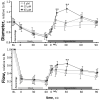Low dose nitrite enhances perfusion after fluid resuscitation from hemorrhagic shock
- PMID: 19804938
- PMCID: PMC2872069
- DOI: 10.1016/j.resuscitation.2009.09.005
Low dose nitrite enhances perfusion after fluid resuscitation from hemorrhagic shock
Abstract
This study determines the systemic and microvascular hemodynamic consequences of administering a low dose sodium nitrite after fluid resuscitation from hemorrhagic shock. Hemodynamic responses to hemorrhagic shock and resuscitation were studied in the hamster window chamber model. Moderated hemorrhage was induced by arterial controlled bleeding of 50% of the blood volume (BV) and the hypovolemic state was maintained for 1h. Volume restitution was performed by infusion of 25% of BV using Hextend (6% Hetastarch 670kDa in lactated electrolyte solution) 10min after fluid resuscitation 100microl of specific concentrations of sodium nitrite were infused. The experimental groups were named based on the nitrite concentration used, namely: 0microM, 10microM and 50microM. Systemic parameters, microvascular hemodynamics and capillary perfusion (functional capillary density, FCD) were followed during entire protocol. Exogenous 10microM nitrite maintained systemic and microhemodynamic conditions post fluid resuscitation from hemorrhagic shock, compared to 50microM or no nitrite. A moderated increase in plasma nitrite during the early phase of resuscitation reversed arteriolar vasoconstriction and increased capillary perfusion and venous return, improving central cardiac function. Nitrite effects on resistance vessels, directly influenced intravascular pressure redistribution, sustained blood flow, and prevented tissue ischemia. In conclusion, increasing nitrite plasma bioavailability after fluid resuscitation from hemorrhagic shock can be a potential therapy to enhance microvascular perfusion and to improve overall outcome.
Figures




References
Publication types
MeSH terms
Substances
Grants and funding
LinkOut - more resources
Full Text Sources

